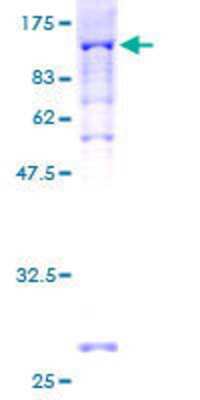PEX5 Products
The product of the PEX5 gene binds to the C-terminal PTS1-type tripeptide peroxisomal targeting signal (SKL-type) and plays an essential role in peroxisomal protein import. Peroxins (PEXs) are proteins that are essential for the assembly of functional peroxisomes. The peroxisome biogenesis disorders (PBDs) are a group of genetically heterogeneous autosomal recessive, lethal diseases characterized by multiple defects in peroxisome function. The peroxisomal biogenesis disorders are a heterogeneous group with at least 14 complementation groups and with more than 1 phenotype being observed in cases falling into particular complementation groups. Although the clinical features of PBD patients vary, cells from all PBD patients exhibit a defect in the import of one or more classes of peroxisomal matrix proteins into the organelle. Defects in this gene are a cause of neonatal adrenoleukodystrophy (NALD), a cause of Zellweger syndrome (ZWS) as well as may be a cause of infantile Refsum disease (IRD). Alternatively spliced transcript variants encoding different isoforms have been identified. (provided by RefSeq)
Show More
11 results for "PEX5" in Products
11 results for "PEX5" in Products
PEX5 Products
The product of the PEX5 gene binds to the C-terminal PTS1-type tripeptide peroxisomal targeting signal (SKL-type) and plays an essential role in peroxisomal protein import. Peroxins (PEXs) are proteins that are essential for the assembly of functional peroxisomes. The peroxisome biogenesis disorders (PBDs) are a group of genetically heterogeneous autosomal recessive, lethal diseases characterized by multiple defects in peroxisome function. The peroxisomal biogenesis disorders are a heterogeneous group with at least 14 complementation groups and with more than 1 phenotype being observed in cases falling into particular complementation groups. Although the clinical features of PBD patients vary, cells from all PBD patients exhibit a defect in the import of one or more classes of peroxisomal matrix proteins into the organelle. Defects in this gene are a cause of neonatal adrenoleukodystrophy (NALD), a cause of Zellweger syndrome (ZWS) as well as may be a cause of infantile Refsum disease (IRD). Alternatively spliced transcript variants encoding different isoforms have been identified. (provided by RefSeq)
Show More
Applications: IHC, WB, ICC/IF
Reactivity:
Human,
Mouse
| Reactivity: | Human, Mouse |
| Details: | Rabbit IgG Polyclonal |
| Applications: | IHC, WB, ICC/IF |
Applications: IHC, WB, ICC/IF, KD
Reactivity:
Human,
Mouse
| Reactivity: | Human, Mouse |
| Details: | Rabbit IgG Polyclonal |
| Applications: | IHC, WB, ICC/IF, KD |
| Reactivity: | Human, Mouse |
| Details: | Rabbit IgG Polyclonal |
| Applications: | IHC, WB |
| Reactivity: | Human |
| Details: | Rabbit IgG Polyclonal |
| Applications: | IHC, WB |
| Reactivity: | Human |
| Details: | Rabbit IgG Polyclonal |
| Applications: | WB |
Applications: WB, ELISA, ICC/IF
Reactivity:
Human,
Mouse,
Rat
| Reactivity: | Human, Mouse, Rat |
| Details: | Rabbit IgG Polyclonal |
| Applications: | WB, ELISA, ICC/IF |
| Applications: | WB, ELISA, MA, AP |
Applications: WB, ELISA
Reactivity:
Human
| Reactivity: | Human |
| Details: | Goat IgG Polyclonal |
| Applications: | WB, ELISA |
| Applications: | WB |
| Applications: | AC |
| Applications: | AC |

![Immunohistochemistry-Paraffin: PEX5 Antibody [NBP1-87185] Immunohistochemistry-Paraffin: PEX5 Antibody [NBP1-87185]](https://resources.bio-techne.com/images/products/PEX5-Antibody-Immunohistochemistry-Paraffin-NBP1-87185-img0019.jpg)
![Western Blot: PEX5 Antibody [NBP2-38443] Western Blot: PEX5 Antibody [NBP2-38443]](https://resources.bio-techne.com/images/products/PEX5-Antibody-Western-Blot-NBP2-38443-img0011.jpg)
![Western Blot: PEX5 Antibody [NBP1-32782] Western Blot: PEX5 Antibody [NBP1-32782]](https://resources.bio-techne.com/images/products/PEX5-Antibody-Western-Blot-NBP1-32782-img0002.jpg)
![Western Blot: PEX5 Antibody [NBP1-54597] Western Blot: PEX5 Antibody [NBP1-54597]](https://resources.bio-techne.com/images/products/PEX5-Antibody-Western-Blot-NBP1-54597-img0002.jpg)
![Western Blot: PEX5 Antibody [NBP1-54585] Western Blot: PEX5 Antibody [NBP1-54585]](https://resources.bio-techne.com/images/products/PEX5-Antibody-Western-Blot-NBP1-54585-img0002.jpg)
![Immunocytochemistry/ Immunofluorescence: PEX5 Antibody [NBP3-36706] - PEX5 Antibody](https://resources.bio-techne.com/images/products/nbp3-36706_rabbit-pex5-pab-10122024120661.jpg)

![Western Blot: PEX5 Antibody [NBP2-44324] Western Blot: PEX5 Antibody [NBP2-44324]](https://resources.bio-techne.com/images/products/PEX5-Antibody-Western-Blot-NBP2-44324-img0001.jpg)
![Western Blot: PEX5 Overexpression Lysate [NBL1-14304] Western Blot: PEX5 Overexpression Lysate [NBL1-14304]](https://resources.bio-techne.com/images/products/PEX5-Overexpression-Lysate-Adult-Normal-Western-Blot-NBL1-14304-img0002.jpg)